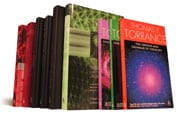For many, the former University of Edinburgh professor Thomas Forsyth Torrance is best known as the person (alongside the late esteemed Geoffrey Bromiley) responsible for translating Karl Barth’s massive (over 10,000 pages) Church Dogmatics into English and introducing the English-speaking world to the towering theology of Karl Barth.
While we should applaud Torrance for this achievement, we should also keep in mind that he too was a top-notch theologian who spent most of his career working tirelessly for the benefit of the Church through his studies of Patristic theology, the person and work of Jesus Christ, the doctrine of the trinity, our knowledge of God, and reconciling theology and the natural sciences.
Torrance never wavered in his devotion to the Church. Born the oldest son of Chinese missionaries, Torrance began his career not as a professor, but as a parish pastor. This experience helped him develop a deep belief that would shape him the rest of his life: Christian thinking and action is for the glory of God and the benefit of the Church. One of the more famous stories of his life is the 81 year old Torrance traversing the mountains of the Wenchuan area of China carrying a money belt containing 11,200 yuan to help rebuild churches destroyed by the communist takeover in 1935. That’s quite an image for an elder theologian of Torrance’s caliber!
But what about his theology? Currently Logos carries four of his publications. Taken together they form a nice introduction his life’s work.
The first, The Christian Doctrine of God, uses Patristic theology to argue that within the life of God there is trinity in unity and unity in trinity. Or to put it another way: in God’s one being there are three persons—God the Father, Son, and Holy Spirit—and those three persons are one being. For the Christian Church, the doctrine of the trinity isn’t some speculative mind exercise but leads us into a deeper place of worship. Further, he adds, understanding who God is in Himself is to know who God is for us. Because, as Torrance never tires of pointing out, there can be no separation between the being of God as Father, Son, and Holy Spirit and how He has gone about saving us.
The second, Space, Time, and Incarnation, addresses two of Torrance’s specialties: Church history and the person of Jesus Christ. Space, Time, and Incarnation is unique in that rather than being a standard Christology volume, it looks at the spatial aspects of the incarnation. Namely, Torrance rejects the Greek philosophical tradition that thinks of space in terms of a container in favor of the early Church’s belief that in the incarnation Jesus Christ made space for himself. This view was made most visibly manifest in the Nicene term homoousious whereby Jesus is affirmed as one substance of God the Father and the term perichoresis in which there is a mutual indwelling between the person of the trinity. According to Torrance this has a profound impact on the way we speak of Jesus’ presence in our life and worship, even shaping the way we think scientifically about nature.
Lastly, Torrance is well-known for his work in combing the Christian faith with the work of the natural sciences. Our last two volumes: The Ground and Grammar of Theology and Divine and Contingent Order address these questions. In both volumes Torrance calls both the theologian and natural scientist alike to forgo the dualistic habits of mind that have dominated scientific thinking in a post-Copernicus landscape. Instead, both the theologian and the scientist have a scientific obligation to faithfully identify and describe phenomena as they are presented to us without rupturing the world into two realms—the spiritual and the phenomenal. Thus, rather than being competing worldviews both the theologian and the scientist are engaged in an enterprise of faithfully describing what God has presented to us. All persons are God’s priests of creation who are charged by God to identify, name and “to bring to expression the manifold realities of the created world around him . . . to bring the universe to view and understanding in its inherent harmonies and regularities and thus to allow the basic design, the meaning, of the universe to become disclosed.”
If you are in the market to grow your theology library, you really should look into Thomas Forsyth Torrance. You can also find three of Torrance’s works in the nine volume Science & Theology Collection!





